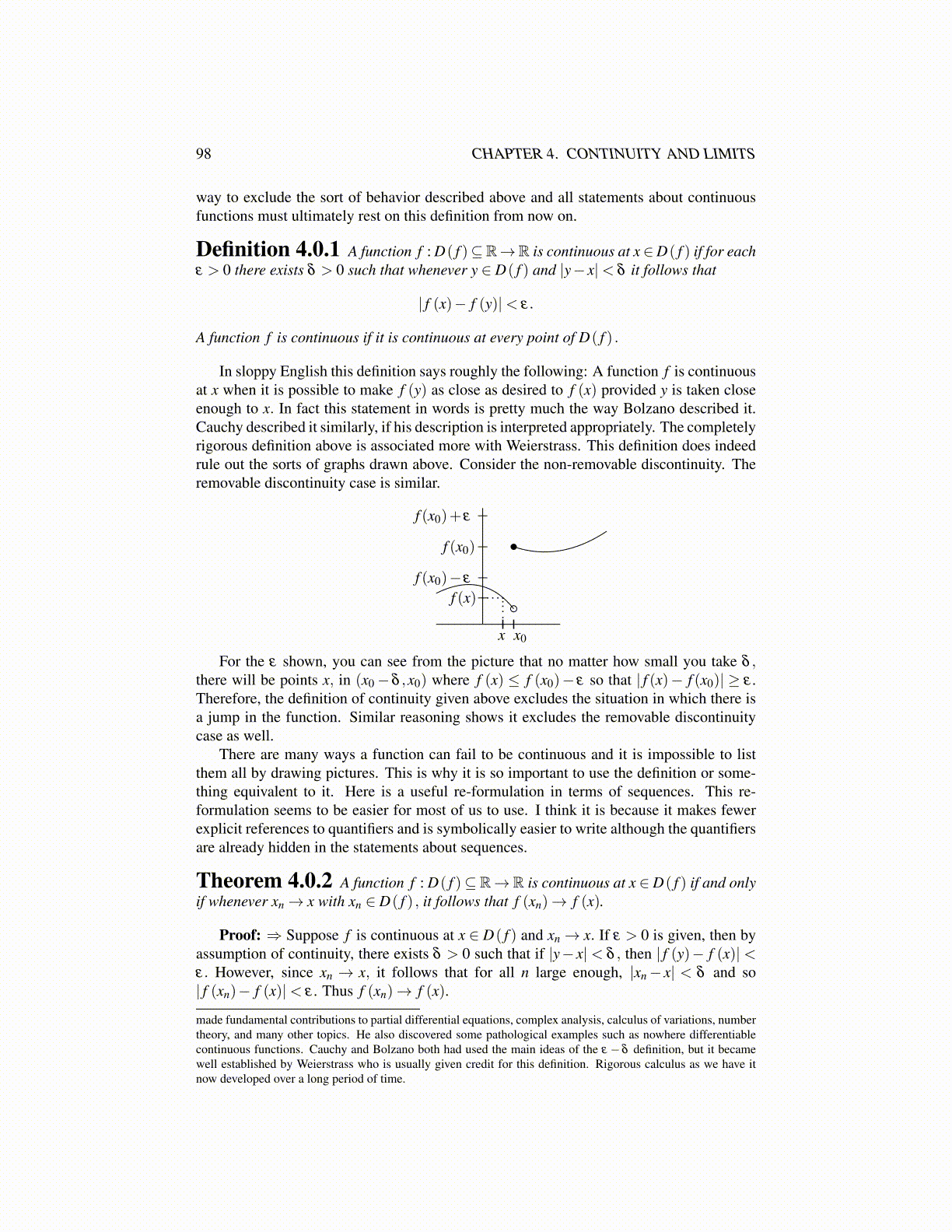
98 CHAPTER 4. CONTINUITY AND LIMITS
way to exclude the sort of behavior described above and all statements about continuousfunctions must ultimately rest on this definition from now on.
Definition 4.0.1 A function f : D( f )⊆R→R is continuous at x ∈ D( f ) if for eachε > 0 there exists δ > 0 such that whenever y ∈ D( f ) and |y− x|< δ it follows that
| f (x)− f (y)|< ε.
A function f is continuous if it is continuous at every point of D( f ) .
In sloppy English this definition says roughly the following: A function f is continuousat x when it is possible to make f (y) as close as desired to f (x) provided y is taken closeenough to x. In fact this statement in words is pretty much the way Bolzano described it.Cauchy described it similarly, if his description is interpreted appropriately. The completelyrigorous definition above is associated more with Weierstrass. This definition does indeedrule out the sorts of graphs drawn above. Consider the non-removable discontinuity. Theremovable discontinuity case is similar.
f (x0)
f (x0)− ε
f (x0)+ ε
f (x)
x x0
For the ε shown, you can see from the picture that no matter how small you take δ ,there will be points x, in (x0 − δ ,x0) where f (x) ≤ f (x0)− ε so that | f (x)− f (x0)| ≥ ε .Therefore, the definition of continuity given above excludes the situation in which there isa jump in the function. Similar reasoning shows it excludes the removable discontinuitycase as well.
There are many ways a function can fail to be continuous and it is impossible to listthem all by drawing pictures. This is why it is so important to use the definition or some-thing equivalent to it. Here is a useful re-formulation in terms of sequences. This re-formulation seems to be easier for most of us to use. I think it is because it makes fewerexplicit references to quantifiers and is symbolically easier to write although the quantifiersare already hidden in the statements about sequences.
Theorem 4.0.2 A function f : D( f )⊆R→R is continuous at x ∈ D( f ) if and onlyif whenever xn → x with xn ∈ D( f ) , it follows that f (xn)→ f (x).
Proof: ⇒ Suppose f is continuous at x ∈ D( f ) and xn → x. If ε > 0 is given, then byassumption of continuity, there exists δ > 0 such that if |y− x| < δ , then | f (y)− f (x)| <ε. However, since xn → x, it follows that for all n large enough, |xn − x| < δ and so| f (xn)− f (x)|< ε . Thus f (xn)→ f (x).
made fundamental contributions to partial differential equations, complex analysis, calculus of variations, numbertheory, and many other topics. He also discovered some pathological examples such as nowhere differentiablecontinuous functions. Cauchy and Bolzano both had used the main ideas of the ε − δ definition, but it becamewell established by Weierstrass who is usually given credit for this definition. Rigorous calculus as we have itnow developed over a long period of time.